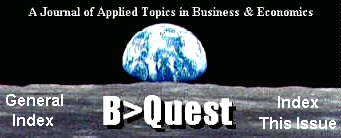|
|
|
May 26, 2004 |
|
|
|
May 26, 2004 |
In a famous Sherlock Holmes passage, the consulting
detective told Watson “the key is the dog.”
Watson replied, “The dog! No one mentioned the dog.
The dog didn’t bark.” Holmes
replied, “That’s the key.”
Recently, I have been telling audiences the key is the
fall in oil prices. They
invariably reply that oil prices are not falling.
I mention that this is May, after the winter heating season and
before the summer driving season and oil prices should fall.
That they are not is the key to whether we will have simultaneous
increases in inflation and reductions in economic growth next year.
Before going further, I should mention that the
surprise is even more substantial for natural gas, which is selling near
$6.50 per thousand cubic feet. To
be sure, some climatologists have suggested that summer will be unusually
warm in the East and South. (At
least we economists know when we don’t know.)
Along with low inventories of energy materials, that has kept energy
prices sky high.
Can these energy prices actually undermine the economic
expansion?
We consume nearly 7.5 billion barrels of oil per year.
At $40 per barrel, that is $300 billion per year.
We also consume about 25 trillion cubic feet of natural gas per year.
That adds another $150 billion in energy consumption at prevailing prices.
With energy at more than 4
percent of GDP, a one third increase in price adds about 1.25 percent to
annual costs of economic
activity.
That is not an economic killer. If all the price gains were at the expense of economic
activity, that kind of price increase would cost about 1.5 million jobs.
A year ago, such a job loss would have been quite
damaging. Today, higher energy
prices will shrink job growth from about 2.5 million this year to only 1
million a year from now. The
unemployment rate will rise back toward 6 percent, but a new recession
should not surface.
Furthermore, not all the higher energy prices would be
at the expense of economic activity. About
half our energy is provided by domestic producers. Their profits will swell and some of those additional
resources will be used to seek alternative sources of energy materials.
We might see slower growth in sales clerks but some jobs for
petroleum engineers.
Some consumers might shift their use of energy
consumption by parking their two ton SUVs and driving their much maligned
passenger cars. (Like Clark
Howard, I own a hybrid. How’s
that for economic forecasting?) Over
time, higher energy prices might again begin the process of reducing energy
consumption per dollar of economic activity.
Between 1973 and the surge of SUV demand in 2000,
energy use declined for every inflation adjusted dollar of economic activity
that was produced. That ceased
to be the case in the past three years.
Perhaps, these higher energy prices will restore the desire to
develop energy efficiency in our consumption patterns.
Nevertheless, these higher energy prices will slow the
growth of economic activity and add to inflationary pressures.
Indeed, world growth probably will be slashed by nearly a percentage
point from more than 4.3 percent this year to less than 3.5 percent next
year. The rebound in our export
industries will slow just as they were showing real momentum.
At the same time, higher energy prices will work into
higher fabrication costs, higher distribution charges, and ultimately,
higher prices for final goods. That,
in turn, will put some pressure on wage demands and professional fees.
When the dust clears, inflation next year could be well over a
percentage point higher next year than if energy prices remained unchanged.
Amazingly, this administration has been buying this
high priced energy to top off the strategic oil reserve. While I agree with the President that oil should not be sold
from the reserve to stabilize prices, I also believe that one buys
inventories when prices are low, not when they are high.
Strategic oil purchases have contributed to the higher gasoline
prices we currently are experiencing.
After next winter, additional pipelines from the
“Stan” republics plus higher expected oil production from the Middle
East should begin to lower oil prices.
I would be surprised if oil prices do not fall next May.
Indeed, we might see $30 oil a year from now. If so, the economic expansion might persist well into 2006.
But there is only a few million barrels a day of idle oil capacity worldwide at this time. If all the Chinese currently riding bikes decide to exchange cars for their two wheelers, that would pretty much use up that capacity. How long can we assume that such a surge in energy consumption will not happen?
